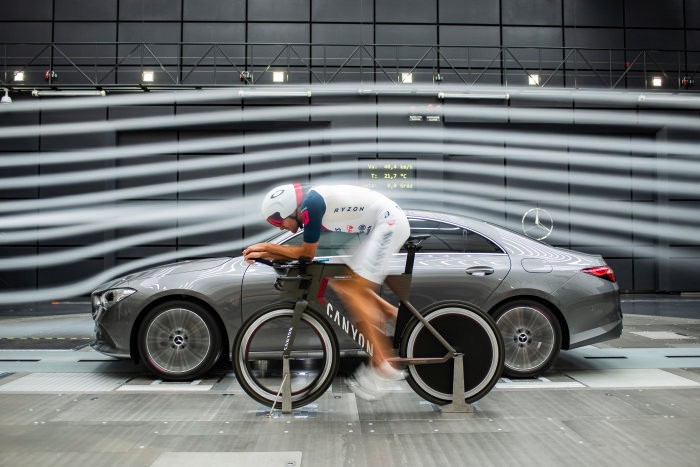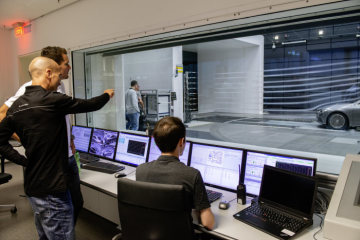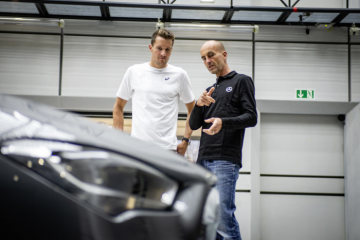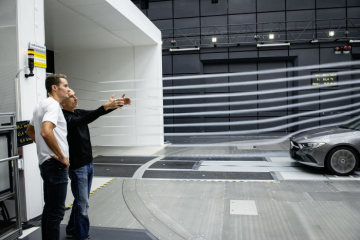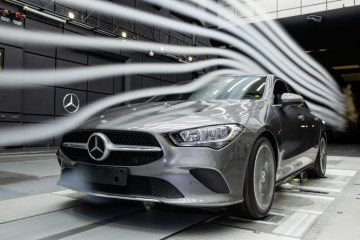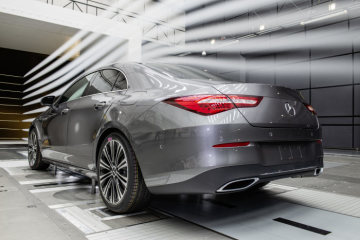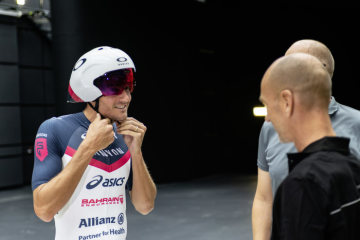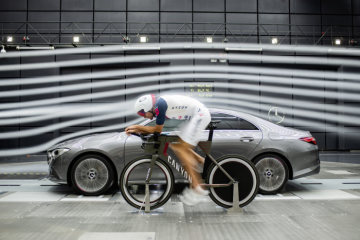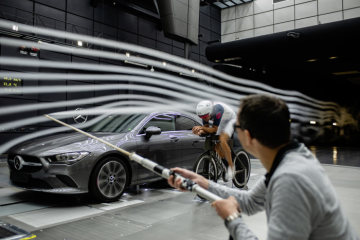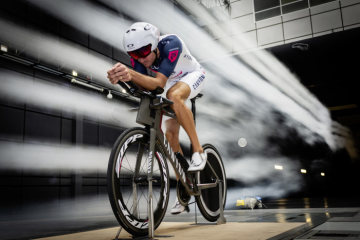
16.
January 2019
Sindelfingen
Sindelfingen. Those who know Ironman Jan Frodeno describe him as a perfectionist who looks for the tiniest technical advantage that could save him time. And in the complex triathlon world it is the cycling leg that is by far the most dependent on optimum technique – in particular on the aerodynamics of the cyclist and their bicycle. Dr Teddy Woll has also made this one of his main missions. However the Head of Aerodynamics at Mercedes-Benz is predominantly concerned about mobility that is as efficient as possible rather than world records or victories. A meeting in the state-of-the-art wind tunnel at Mercedes-Benz in Sindelfingen.
What is the significance of aerodynamics as far as you are concerned?
- Jan Frodeno: Aerodynamics plays a really fundamental role in the central part of a long-distance triathlon, the 180 km cycle ride. In particular at the World Championships in Hawaii we have to fight against strong gusts of wind as well as the wind resistance. This makes the issue especially complex. And you need to know that it's not just the aerodynamics of the wheel that makes the difference, it's the decisive interplay between the bike and its rider. Because the body causes around 80 percent of the contact surface for the wind. It's definitely worth a few hours in the wind tunnel to find the ideal seat position.
- Teddy Woll: Aerodynamics are an intelligent way of cutting fleet consumption and also help to close the gap between certified and actual consumption. As the wind resistance grows with the square of the speed, a cd value reduction brings advantages above all at a higher speed. An aerodynamic design is also so important because the vehicles' frontal area is tending to increase: people are getting taller, the battery in electric vehicles needs space and lots of customers prefer an SUV. We are all the prouder that in the new compact cars we have managed for the first time to cut the cd figure yet again and also made the frontal area smaller, in spite of wider wheels and more space in the vehicle.
When it comes to the aerodynamics of the bicycle or car, what kind of ballpark figures are we talking about?
- Frodeno: Anyone out for a leisurely ride on a touring bike has a Cd value of around 0.7 m². A mountain biker has about 0.6 m², a racing biker 0.5 m². With me – in combination with a helmet, the pre-determined seat position and an aerodynamically optimised bike – a Cd figure of 0.21 m² was measured. So anyone riding a Dutch bike has to overcome three times the resistance, and at as much as nine times the resistance at twice the speed!
- Woll: Our best is currently the A-Class Saloon. With a cd value of 0.22 it achieves the current world record amongst series vehicles and has a frontal area of around 2.19 m². This adds up to a drag coefficient of 0.49 m². Two people in an A-Class are therefore much more aerodynamic then two racing bike riders – despite triple the frontal area.
Is it possible to put the benefit of better aerodynamics in figures?
- Frodeno: As the external circumstances are permanently changing, it is so difficult to quantify it in absolute terms. But one thing is clear: the less energy I need the faster I can cycle – or I can save energy for the marathon to come. So we cyclists measure aerodynamics in watts – the power we have to generate in order to overcome the wind resistance – or how many watts we can save at a target speed of, say, 45 km/h.
- Woll: If it is possible to cut the cd figure by one hundredth, so for example 0.24 to 0.23, the fuel consumption in the customer average falls by one tenth of a litre, at a motorway speed of 140 km/h by approx. 0.2 litres per 100 kilometres or 5 grams of CO2 per kilometre. Today there is no measure that cuts this much consumption at such low costs. To achieve the same saving with lightweight-construction measures in real traffic we would have to reduce the weight of our cars by at least 50 kilograms, and at a motorway speed of 140 by as much as 200 kg.
What improvement have you achieved in the course of your career?
- Frodeno: In the last few years we have concentrated on working on the bike itself with my bike partner Canyon and we have improved the handlebars and the cockpit. We also tinkered with my seat position and developed a new helmet too. This all resulted in successes. But you also always have to keep an eye on the biomechanics. Because you also have to put power on the pedal too and above all in an Ironman you have to be able to stay in the seat position for 4 hours. It doesn't help one bit if you save 10 W of air resistance in the wind tunnel but the position is then so "uncomfortable" that your performance decreases by 20 W or you can't run properly afterwards. Finding this balance and the perfect point between aerodynamics and biomechanics is our biggest challenge.
- Woll: We also have a conflict of interests with different demands when it comes to a vehicle – that's why not every model is always more aerodynamic than its predecessor. But generally speaking we have made huge progress in the last few years. One spectacular example is the leap the SUVs have made, from the first M-Class with cd 0.40 to the new GLE, which achieves a new best cd figure in the segment, 0.29. In this period the saloons have clocked up an improvement of some 20 percent. In recent years we have made great progress thanks to the digitisation of the development process, as calculations are very much faster and much more refined. Digital vehicle models nowadays have over 100 million cells, and can produce results overnight with a precision of over 99 percent. Not that long ago, this same simulation would have taken 6 months and would have been very imprecise. Then there is the fact that today we collaborate very well with our colleagues from Design and we have developed a huge mutual understanding. And it certainly makes us proud that we are setting the trend for the entire car industry in this field.
And where are the improvements taking place?
- Frodeno: Take a look at my current racing bike. My partners at Canyon really took care of every last detail. For instance, my Speedmax CF SLX has a tailor-made cockpit: in order to keep the frontal area as small as possible Canyon milled a special attachment that sits in the centre of the stem. And Continental made me a special tyre with the low rolling resistance of the GrandPrix TT and the reduce wind resistance of the GrandPrix 4000 S2: through the profile in the tread the wind dissipates faster, which saves one to two W compared with the smooth tread of the TT.
- Woll: This encompasses three areas – the air flow through the engine compartment, the air flow around and within the front wheels, and the underbody. These measures include, for example, the latest generation of active radiator shutters, a complex interplay between 3D wheel spoilers, slotted wheel arch liners and aero wheels, fully trimmed underbodies and also the active level control system on some vehicles. But we take a close look at every nook and cranny of the vehicle, from the front apron with all its edges and apertures to the small spoiler lips in the lenses of the tail lights, to perfect the breakaway of the air flow at the rear.
Will the development then continue or has the end of the road been reached?
- Frodeno: Development is always ongoing as long as weirdos like me are so obsessed with every detail. If you want to win you have to be better than the rest. And this means that if you stand still you fall behind. We constantly have to learn, measure, buy, develop – and start all over again.
- Woll: And that is precisely our attitude too. Our company motto "The best or nothing" amounts to the same thing. Of course we are gradually approaching an asymptotic limit if we do not dramatically change the appearance of our cars, e.g. by making them much longer and sleeker, and equipping them with slim rear ends and narrow wheels. Fortunately, however, we can always still find details where improvements are possible — both in the wind tunnel and, increasingly often, on the computer. After all, aerodynamics is the most efficient way to even more efficiency.
In conversation
Jan Frodeno (37) was the first triathlete to win both Olympic gold (Peking 2008) and the Ironman World Championship title in Hawaii (2015, 2016). He is Germany's most successful triathlete and also a legend worldwide. Since July 2016 he has held the record for the best time in the world, 7:35:39 hours for a long-distance triathlon, which he set at Challenge Roth.
Dr-Ing Teddy Woll (56) studied business engineering sciences, specialising in electrical engineering at the TU Darmstadt. His doctorate was on the topic of "Measurement of intraocular pressure with a closed eyelid" and in parallel, with the Akasol he developed solar-powered and light electric vehicles, which achieved successes such as winning the Tour de Sol three times. After two years at smart Woll moved to Advance Development at Daimler AG in 1996 and since 1999 he has headed the Aerodynamics and Wind tunnels department.
The aeroacoustic wind tunnel: measurements up to 265 km/h
With its "large wind tunnel" in Stuttgart-Untertürkheim – the first measurement was recorded 75 years ago, on 5 February 1943 – Mercedes-Benz was the first automotive manufacturer to have its own wind tunnel. The new aeroacoustic wind tunnel at the development centre in Sindelfingen, which commenced operation in September 2013, once again put the company at the forefront of aerodynamic testing. The wind tunnel follows the so-called Göttingen design, whereby the air is redirected to the blower after the measuring section and then re-accelerated to 265 km/h. Before the air accelerated by the blower reaches the measuring section, via a nozzle system that encompasses 28 sq m, it must be straightened and smoothed to eliminate unwanted turbulence and eddies. This is done using rectifiers and sieves. Extensive noise insulation measures are integrated to allow use as an acoustic tunnel where interior and exterior wind noise can be measured for the relevant test vehicle. Even at 140 km/h the air flowing through the measuring section is therefore as quiet as a whisper.
The centrepiece of the 19-metre-long measuring section in the wind tunnel is the roughly 90-ton conveyor belt/balance system with a turntable. Five separate belt conveyors simulate the road, whose movement relative to the vehicle influences the air flow in particular on the underbody. The conveyor belt/balance system is integrated into a turntable with a diameter of twelve metres, which means that the test vehicles can also be subjected to an angled flow of air in order to simulate cross-winds.
The aerodynamics world champion from Mercedes-Benz: A-Class Saloon
Fresh wind for saving fuel: for three decades now, the aerodynamics engineers at Mercedes-Benz have been setting one record after another. The world record for series production vehicles is currently held by the new A-Class Saloon with a cd value of 0.22 and a drag of less than 0.49 m2. It thus defends the original world record set by the CLA Coupé, the new model of which achieves 0.23 cd, still an outstandingly good figure.
The good aerodynamic properties make a key contribution to low fuel consumption under everyday conditions. The A-Class Saloon was improved down to the smallest detail by a multiplicity of computation loops, CAE simulations (computer-aided engineering) and measurements in the wind tunnel in Sindelfingen. In addition to the outstanding exterior shape, there are many small measures that led to the new record: a sophisticated reduction of the frontal area despite significantly improved interior comfort dimensions, an extensive sealing concept (such as the sealing of the headlamp surroundings) as well as almost complete panelling of the underbody, which includes the engine bay, main floorpan, parts of the rear axle and the diffuser.
The front and rear wheel spoilers were optimised specifically to route the air around the wheels as efficiently as possible. The rims and tyres also underwent aerodynamic fine-tuning. Depending on the market, an optional two-part shutter system behind the radiator grille is available, which minimises the airflow through the engine bay.
The A-Class Saloon was launch at the end of 2018. The four-door notchback has the wheelbase of the hatchback (2729 millimetres) as well as the proportions of a dynamic and yet compact saloon with short overhangs at front and rear. It is at the top of its segment with regard to rear headroom. In addition, the saloon model has the familiar A-Class virtues. These include modern, efficient engines, a high level of safety thanks to state-of-the-art driving assistance systems with S-Class functions, and the intuitively operated and learning MBUX – Mercedes-Benz User Experience infotainment system.
Press Contact
- Manager Communications Compact Cars
- markus.nast@daimler.com
- Tel: +49 711 17-96357
- Fax: +49 711 17-79055289
- Head of International Product & Technology Communications
- koert.groeneveld@daimler.com
- Tel: +49 711 17-92311
- Fax: +49 711 17-94365
Press Contact Overview
Media
Download
Filter
Show thumbnails
Show list
Slideshow

Do you really want to delete the data record?
Please wait a moment …
Please wait a moment …
Please wait a moment …
Please wait a moment …
-
18C0895_003
-
18C0895_010
-
18C0895_023
-
18C0895_030
-
18C0895_032
-
18C0895_035
-
18C0895_037
-
18C0895_038
-
18C0895_046

LoadingOriginal Article
